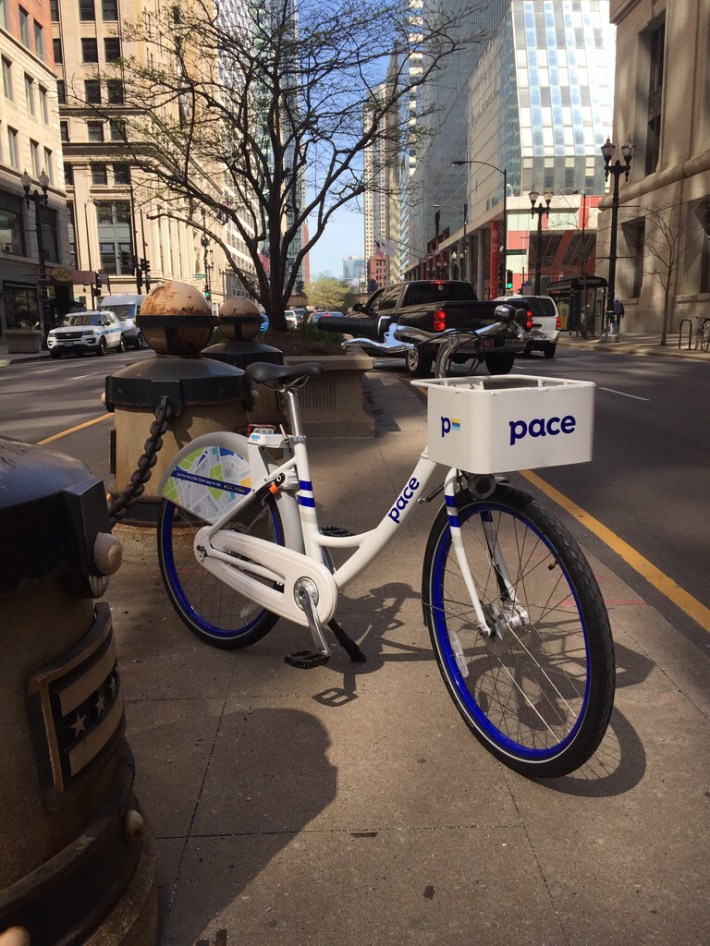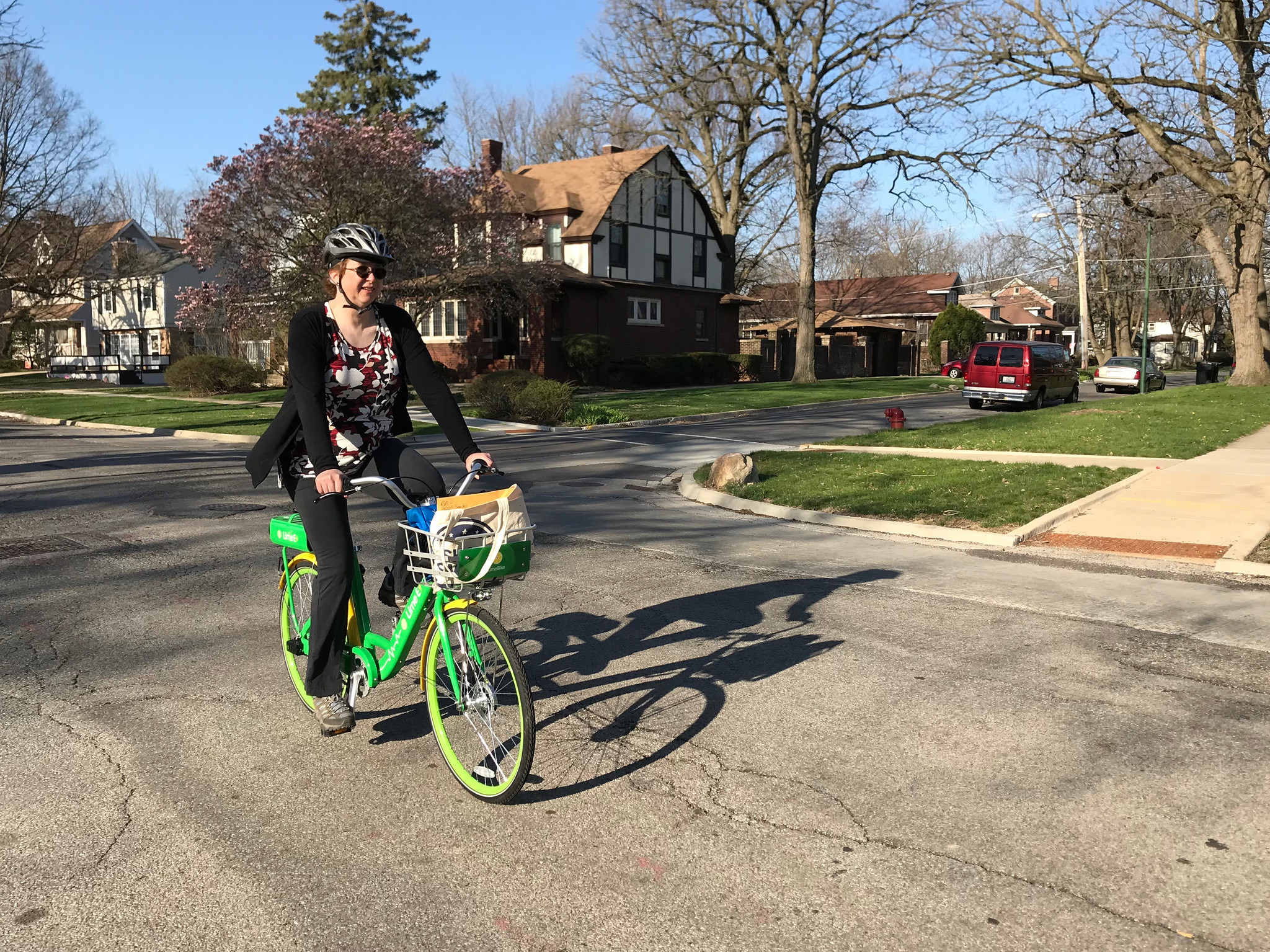[This article also runs in the Chicago Reader.]
Update 5/2/18, 8:45 AM: The announced yesterday evening that Ofo's permit is approved. They will be releasing 50 "free-locked" bikes in the near future.
After months of pushing by cycling advocates to bring dockless bike-share to Chicago, the technology finally debuted this morning in Beverly as 19th Ward alderman Matthew O'Shea cut the ribbon on a fleet of shiny new LimeBike cycles in the County Fair Foods parking lot. Meanwhile competing vendor Zagster is also rolling out bikes today, and dockless cycles from the companies Ofo and JUMP will likely be popping up on south side streets any time now.
Dockless bike share, which some call "DoBi," lets members use a smartphone app to locate and rent the bikes—which can be left anywhere within a designated service area. The dockless companies offer cheap rental rates, generally $1 for a half-hour trip, compared to $3 for a single Divvy journey.
Transportation equity groups like Slow Roll Chicago and Equiticity have called on the city of Chicago to allow dockless vendors to set up shop here as a strategy to provide shared bikes to outlying neighborhoods that don’t have Divvy stations. The city seemed to drag its feet on the issue, partly out of concerns that DoBi would cannibalize Divvy ridership.

But last week the Chicago Department of Transportation released the permitting regulations for a six-month dockless pilot, which limit the technology to city neighborhoods south of 79th Street (minus the South Chicago community), largely outside the Divvy coverage area. And while LimeBike uses "free-floating" bikes, which are only secured with built-in wheel locks, after July 1 the rules will require companies to use models with built-in U-locks or cables for securing the cycles to bikes racks, poles, or parking meters.
It's more than a little ironic that Alderman O'Shea is the poster boy for dockless bike share, since during a 2012 budget hearing he told then-CDOT chief Gabe Klein, "If you never put a bike lane in my ward, that's too soon." At this morning's event O'Shea told me he was aggravated with the poor state of road paving in the ward at the time. "My frustration with the DOT boiled over and I said something I probably shouldn't have."
O'Shea told me his attitude toward bike infrastructure has evolved since then, especially after thousands of residents stated on a 2015 Beverly Area Planning Association survey that they wanted Divvy stations for the neighborhood. The alderman said that not long after CDOT informed him that Divvy stations wouldn't be coming to the far southwest side anytime soon, he learned about dockless bike share and became interested in bringing it to the ward. "We have a tremendous number of bike enthusiasts in the neighborhood and several community bike events," O'Shea said. For example, the Intelligentsia Cup bike race will be coming to Beverly in July. "I just knew bike sharing would be a success here."

But will it be? Some commentators have argued that the rules of the test, which limit dockless bikes to the southern fifth of the city, which has a relatively low density of people, retail destinations, and bike lanes, will set vendors up for financial failure. Moreover, companies with free-floating bikes, like LimeBike and Ofo, may only release 50 bikes for starters before replacing them with "lock-to" bikes in July. Companies with the latter style of cycles, such as Zagster and Jump, are allowed to put up to 250 bikes on the street this month.
But this morning LimeBike's Chicago manager, Jessie Lucci, told me she's confident the company can squeeze success out of the narrow parameters of the pilot. It’ll be distributing the cycles at transit stations, schools, and parks all over the far south side. (The rules require the bikes to be “rebalanced” daily, so that no fewer than 15 percent of a company's fleet is present in any of the quadrants of the service area, which is generally bifurcated by 130th and State Streets.) "We're excited to be serving the areas that historically haven't had access to Divvy bikes," she said.
As for the lock-to requirement, Lucci said the company plans to see how free-floating bikes work out in Chicago before deciding whether to retrofit its current bikes, order new ones, or lobby CDOT to change the rules. In many other cities, wheel-locked dockless bikes have been photographed strewn across sidewalks, hanging from trees, or submerged in bodies of water, something that Chicago's lock-to rule is intended to prevent. "From now until July 1 is a long time for us as start-up," Lucci said.

Unlike its fleet in Rockford, Illinois, where LimeBike launched with 400 bikes in early April, the company’s Chicago fleet solely features battery-powered electrical-assist cycles, which offer a zippy, sweat-free ride. While they don't provide as much exercise as a regular bike, these e-bikes will be handy for south-side cyclists who need to cover larger distances than their north-side counterparts, especially in underserved communities where retail nodes and job sites are fewer and farther between. On the other hand, the electric cycles are a lot more expensive to rent—$1 to unlock, plus 15 cents a minute to ride.
Also this morning, Zagster announced that CDOT approved its permit Monday to launch 50 of its Pace- model bikes (which have built-in cable locks), with plans to quickly scale up to 250. Spokeswoman Danielle Toboni argued that Zagster's lock-to bikes are superior to free-floating ones. "Instead of allowing bikes to lock anywhere like some of the other guys," she said, "Pace bikes must lock to a Pace rack, public rack or any other legal bike parking structure to end a ride. This protects the public right of way and keeps city officials and constituents happy."
Also Monday, an Ofo spokesman told me the company was waiting for the city to approve its permit. And at the Beverly launch, LimeBike lobbyist John Dunn told me that Jump, which features bikes with built-in U-locks, will also be launching an all-electric fleet in Chicago in the near future.
Looks like it won't be long until far-south-siders have a rainbow of DoBi cycles to choose from. But whether the bikes will get good use, or get dumped in Lake Calumet, is anybody's guess.





